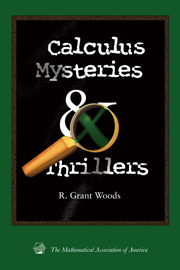Book contents
- Frontmatter
- Dedication
- Contents
- The Purpose of This Book
- An Overview of the Projects
- Detailed Mathematical Requirements
- The Projects
- The Solutions
- 1 The Case of the Parabolic Pool Table—Solution
- 2 Calculus for Climatologists—Solution
- 3 The Case of the Swiveling Spotlight—Solution
- 4 Finding the Salami Curve—Solution
- 5 Saving Lunar Station Alpha—Solution
- 6 An Income Policy for Mediocria—Solution
- 7 The Case of the Cooling Cadaver—Solution
- 8 Designing Dipsticks—Solution
- 9 The Case of the Gilded Goose-egg—Solution
- 10 Sunken Treasure—Solution
1 - The Case of the Parabolic Pool Table—Solution
from The Solutions
- Frontmatter
- Dedication
- Contents
- The Purpose of This Book
- An Overview of the Projects
- Detailed Mathematical Requirements
- The Projects
- The Solutions
- 1 The Case of the Parabolic Pool Table—Solution
- 2 Calculus for Climatologists—Solution
- 3 The Case of the Swiveling Spotlight—Solution
- 4 Finding the Salami Curve—Solution
- 5 Saving Lunar Station Alpha—Solution
- 6 An Income Policy for Mediocria—Solution
- 7 The Case of the Cooling Cadaver—Solution
- 8 Designing Dipsticks—Solution
- 9 The Case of the Gilded Goose-egg—Solution
- 10 Sunken Treasure—Solution
Summary
To: Judge Vance Frito
From: Math Iz Us
In the matter of: The People vs. Mr. Luigi McTavish
Your Honor,
In this brief we shall show that Mr. Luigi McTavish did keep in the establishment known as Luigi's Lizard Room, owned by Mr. MacTavish, two pool tables of similar design but different dimensions to aid and abet a fraudulant gambling scheme. We shall further show that the table used by Mr. McTavish was designed so that McTavish could win a bet with his co-gambler, while the table used by the co-gambler was designed to render it impossible for said co-gambler to win. This submission shall constitute evidence corroborating the charge of fraud against Mr. McTavish.
Consider a pool table constructed so that three of its sides comprise three of the four sides of a a rectangle, while the fourth side has been replaced by a portion of a parabola bulging outwards, a parabola whose axis of symmetry is the perpendicular bisector of the opposite side of the rectangle (see Exhibit A). This implies that the vertex of the parabola must be at the intersection of the parabola with said perpendicular bisector. A cue ball is placed at the midpoint of the "missing" fourth side of the rectangle, denoted by an 'x' on Exhibit A. The cue ball is to be shot against the parabolic portion of the cushion. The gambler wins if the cue ball returns over the x from which it was shot. We shall consider what the relative dimensions of the rectangular and parabolic portions of the pool table must be in order for this to be possible.
- Type
- Chapter
- Information
- Calculus Mysteries and Thrillers , pp. 67 - 70Publisher: Mathematical Association of AmericaPrint publication year: 1998



